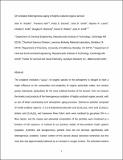OH-Initiated Heterogeneous Aging of Highly Oxidized Organic Aerosol
Author(s)
Kessler, Sean Herbert; Nah, Theodora; Daumit, Kelly Elizabeth; Smith, Jared D.; Leone, Stephen R.; Kolb, Charles E.; Worsnop, Douglas R.; Wilson, Kevin R.; Kroll, Jesse; ... Show more Show less
Downloadshk_acidox_manuscript_FINAL.pdf (955.6Kb)
OPEN_ACCESS_POLICY
Open Access Policy
Creative Commons Attribution-Noncommercial-Share Alike
Terms of use
Metadata
Show full item recordAbstract
The oxidative evolution (“aging”) of organic species in the atmosphere is thought to have a major influence on the composition and properties of organic particulate matter but remains poorly understood, particularly for the most oxidized fraction of the aerosol. Here we measure the kinetics and products of the heterogeneous oxidation of highly oxidized organic aerosol, with an aim of better constraining such atmospheric aging processes. Submicrometer particles composed of model oxidized organics—1,2,3,4-butanetetracarboxylic acid (C[subscript 8]H[subscript 10]O[subscript 8]), citric acid (C[subscript 6]H[subscript 8]O[subscript 7]), tartaric acid (C[subscript 4]H[subscript 6]O[subscript 6]), and Suwannee River fulvic acid—were oxidized by gas-phase OH in a flow reactor, and the masses and elemental composition of the particles were monitored as a function of OH exposure. In contrast to our previous studies of less-oxidized model systems (squalane, erythritol, and levoglucosan), particle mass did not decrease significantly with heterogeneous oxidation. Carbon content of the aerosol always decreased somewhat, but this mass loss was approximately balanced by an increase in oxygen content. The estimated reactive uptake coefficients of the reactions range from 0.37 to 0.51 and indicate that such transformations occur at rates corresponding to 1–2 weeks in the atmosphere, suggesting their importance in the atmospheric lifecycle of organic particulate matter.
Date issued
2012-04Department
Massachusetts Institute of Technology. Department of Chemical Engineering; Massachusetts Institute of Technology. Department of Civil and Environmental EngineeringJournal
Journal of Physical Chemistry A
Publisher
American Chemical Society
Citation
Kausel, Eduardo. “Number and Location of Zero-group-velocity Modes.” The Journal of the Acoustical Society of America 131.5 (2012): 3601.
Version: Author's final manuscript
ISSN
1089-5639
1520-5215